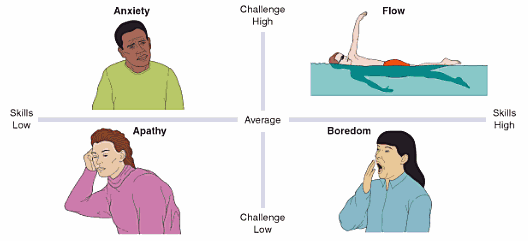Being in “the zone” is a universal phenomenon experienced by almost all elite athletes. So what is this “zone”? How can athletes find it? And how does it affect athletic performance? Not surprisingly, sport psychologists have been asking these questions for many years; and luckily, they have come up with some interesting and helpful conclusions about this “zone” and how it influences athletes.
In the simplest terms, the “zone” (or “flow” as some sport psychologists’ call it), is generally described as “the pinnacle of achievement for an athlete”, and characterizes “a state in which an athlete performs to the best of his or her ability” (Young & Pain 1999). It combines a balance of excitement and awareness, and is often associated with a relaxed yet focused high-level performance (Caruso 2005).
Ravizza (1977, 1984), Loehr (1986), Garfield and Bennett (1984), Jackson (1992, 1993, 1995, 1996), and Young (1999a, 1999b, 1999c, 1999d) are just a few of the researchers who have investigated the characteristics and dynamics of the zone. Obviously, the undeniable impact that flow has on an athlete’s game makes it a popular area of study. In the most recent examination of flow by Jackson and Csikszentmihalyi (1999), 10 essential elements of the zone were identified. Weinberg and Gould (2011) do an excellent job of summarizing each element. They are as follows:
1. Balance of challenge and skills: For flow to occur it is imperative that an athlete believes that he or she has the skills to successfully meet the physical, technical, and mental challenges faced (see Image 1).

2. Complete absorption in the activity: The participant is so involved in the activity that nothing else seems to matter.
3. Clear goals: Goals are so clearly set that the athlete knows exactly what to do. This clarity of intention facilitates concentration and attention.
4. Merging of action and awareness: The athlete is aware of their actions but not of the awareness itself.
5. Total concentration on the task at hand: Performers report that they feel like a beam of concentrated energy. Crowd noise, opponent reactions, and other distractions simply don’t matter. The focus of attention is clearly on the task at hand.
6. Loss of self-consciousness: Performers report that their ego is completely lost in the activity itself.
7. A sense of control: This element of flow refers to the fact that the athlete is not actively aware of control; rather, they are simply not worried by the possibility of lack of control.
8. No goals or rewards external to the activity: The athlete participates purely because of the activity itself, without seeking any other reward.
9. Transformation of time: Athletes in flow typically report that time seems to speed up, although for some it slows down. However, most individuals in flow report transformations in their perceptions of time.
10. Effortless movement: This element refers to the fact that the athlete is performing well but yet is not really thinking about it and doesn’t appear to be trying too hard.
An athlete in the zone is not only able to suppress and ignore negative thoughts, but they are also found to have higher self-esteem and confidence (Carstedt 2003). Clearly, achieving flow or being in the zone gives an athlete a remarkable advantage. The ability to repress negative thoughts and focus on the task at hand is a crucial part of performing at an elite level. Getting in – and staying in the zone is a skill that all athletes should master.
In this article we discussed what the zone is, what athletes experience while in the zone, and how it affects athletic performance. In Part II of Finding The Zone, we will discuss how one can get in the zone as well as factors that prevent and disrupt athletes from getting in the zone.
References:
Carstedt, R.A. (2003) Critical Moments During Competition: A Mind-Body Model of Sport Performance when it Counts the Most. New York City, NY: Psychology Press
Caruso, A. (2005) Sports Psychology Basics. Ann Arbor, MI: Reedswain
Jackson, S.A., & Csíkszentmihályi, M. (1999) Flow in Sports. Champaign, IL: Human Kinetics
Kimiecik, J.S., & Stein G. (1992) “Examining the Flow Experiences in Sport Contents: Conceptual Issues and Methodological Concerns”, Journal of Applied Sport Psychology Vol. 4 Issue 2, p. 147
Weinberg, R.S., & Gould, D. (2011) Foundations of Sport and Exercise Psychology. Champaign, IL: Human Kinetics
Young, J.A., & Pain, M.D (1999) “The Zone: Evidence of a Universal Phenomenon for Athletes Across Sports”. Athletic Insight Vol. 1 Issue 3, pp.:21-30